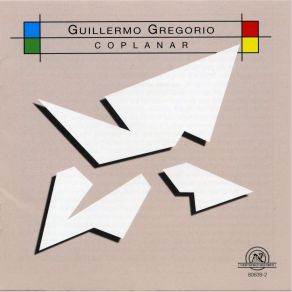Guillermo Gregorio: Coplanar
Download links and information about Guillermo Gregorio: Coplanar by Guillermo Gregorio. This album was released in 2002 and it belongs to genres. It contains 8 tracks with total duration of 01:16:32 minutes.

|
|
|---|---|
| Artist: | Guillermo Gregorio |
| Release date: | 2002 |
| Genre: | |
| Tracks: | 8 |
| Duration: | 01:16:32 |
| Buy it NOW at: | |
| Buy on iTunes $9.99 | |
Tracks
[Edit]| No. | Title | Length |
|---|---|---|
| 1. | Coplanar 1 + 2 (featuring John Corbett, Jim Baker, Madi Ensemble) | 16:31 |
| 2. | Coplanar 4 (featuring Kyle Bruckmann) | 5:31 |
| 3. | Coplanar 3 (featuring Fredrick Lonberg - Holm, Steffen Schleiermacher, Michael Cameron) | 7:31 |
| 4. | White Coplanar | 6:30 |
| 5. | Construction With Coplanar (featuring Kyle Bruckmann) | 11:22 |
| 6. | Madi Piece (featuring John Corbett, Michael Cameron) | 6:40 |
| 7. | Swiss Coplanar (featuring Jim Baker, Jennifer Walshe) | 8:45 |
| 8. | Coplanar 5 (featuring Madi Ensemble) | 13:42 |
Details
[Edit]Guillermo Gregorio might be considered a musical renaissance man. He has deep-rooted mainstream jazz and bop influences, and has experimented with electronics while also studying classical music. In a roundabout way, the title of this release refers to textures, the Russian avant-garde movement, art objects, and artistically inspired philosophies. And while this record label generally focuses on contemporary classical frameworks, Gregorio employs noteworthy modern jazz musicians such as guitarist Jeff Parker, clarinetist François Houle, and others. The overall tone and structural design of this outing is quite compelling, as Gregorio conducts his strings, horns, and rhythm section while also performing on clarinet. Certain pieces feature soft vibes intermingling with Parker's ringing harmonics and percussionist Carrie Biolo's abstract permutations, as the band utilizes space as a vehicle for realignment. Gregorio imports minimalist notions into his repertoire amid the musicians' contrapuntal statements and complexly fabricated micro-motifs, whereas cellist Fred Lonberg-Holm and oboist Kyle Bruckmann render memorably melodic unison choruses on the piece titled "Part One." Either way, no two passages are alike, which is a characteristic that provides an ephemeral nature to this project when viewed as a whole.